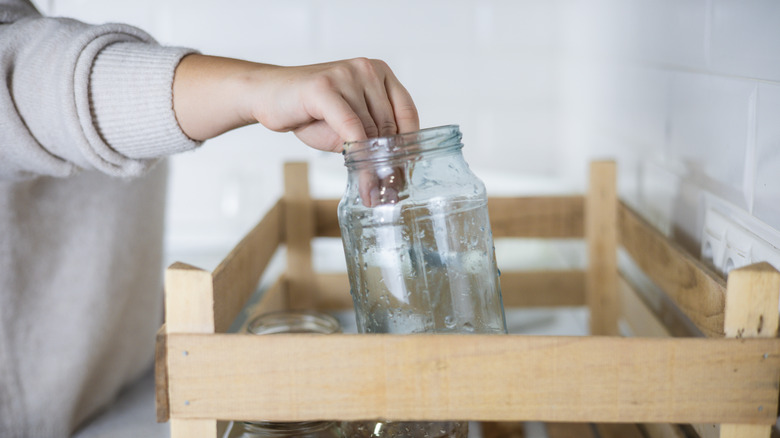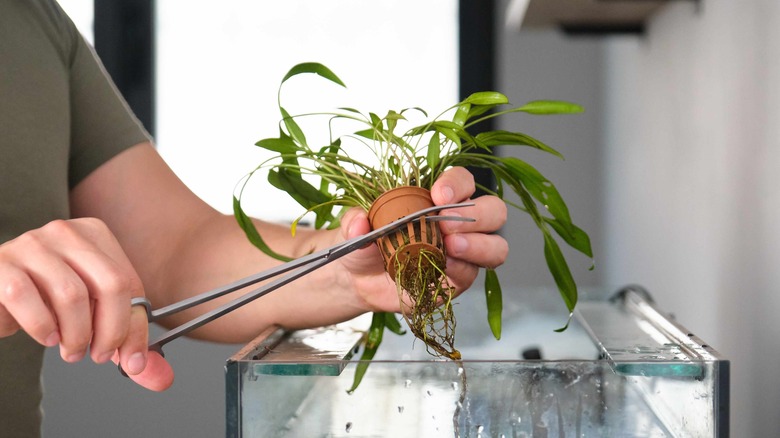Grow Aquatic Plants Without An Aquarium Using This Jar Hack
Some houseplants enjoy a bit of boggy soil, and there are a surprising number of indoor plants that can grow in water indefinitely. But these plants aren't completely submerged in the water like a truly aquatic plant is. If you're not a fan of looking after fish or other water-loving pets, you've probably discounted the idea of growing aquatic plants at home altogether. You need a fish tank or aquarium to do so, right? Wrong! You can successfully cultivate a delicate Madagascar lace plant or some fluffy hornwort in something as small and cheap as an upcycled jar, so long as you follow a few simple steps. That is, choose a clean, transparent glass jar, fill it with aquarium gravel, plant your plants, then fill the whole thing with fresh water. It's easier than you think!
This is the perfect project for passionate plant parents who have learned everything there is to know about terrestrial houseplant care and are looking for a new challenge. Maybe you're intrigued by water gardening but don't live in the right climate to tend to outdoor aquatic plants. Perhaps you want a gardening project to tackle during the winter months when your backyard is buried in snow. Growing a single aquatic plant in a jar is also cheaper and involves far less maintenance than aquascaping an entire aquarium. But you still get to experience the joy and relaxation of watching leaves sway in gently moving water.
The aquatic plant species you can grow indoors
Horticulturally, aquatic plants are divided into four main categories. Submersed plants, as their name suggests, live all their lives completely underwater, while the new growth of emergent plants peeps above the water. The stems and roots of floating-leaved plants are underwater, and the leaves and flowers float on top. Floating plants drift on the water's surface, with only their roots submerged. To achieve the right aesthetics for this indoor gardening project, choose either emergent or submersed plants, or a combination of both.
The popular aquarium plants sold by nurseries are pretty much the same as the aquatic plants you add to your natural water features. When aquascaping a jar for the first time, choose easy-to-care-for freshwater plants that thrive in small spaces and are cold-tolerant. Some species and cultivars to consider include Anubias, Java fern (Microsorum pteropus), Bacopa caroliniana, dwarf sagittaria (Sagittaria subulata), and the aforementioned hornwort (Ceratophyllum demersum) and Madagascar lace plant (Aponogeton madagascariensis).
Some people eschew aquatic plant nurseries in favor of collecting wild plants. Not only can removing wild plants from their natural habitat disrupt local ecosystems, but U.S. regulations on wild plant harvesting vary. For example, in Southeast Alaska, you need an up-to-date fishing license and can only collect plants for non-commercial use. You have to apply for a collection permit to forage in national forests and parks. If you want to take plants from a stream, river, or lake, check with your local municipal authority.
How to put together a thriving plant-only aquascape in a jar
Any transparent glass jar or vase works, so long as it's clean. Amatuer aquaculturalist and YouTuber Green Sapling created a jarrarium, as these underwater gardens are often called, in a matchbox-sized jar! It's easier, however, to use something with a wide mouth that's at least Mason jar-sized. Just like potted terrestrial plants, aquatic plants need something to sink their roots into. Use gravel or regular potting mix that's free from fertilizer or other additives. Alternatively, soil from your garden, sifted to remove impurities and insects, provides a ready-made source of nutrients. Top the soil with a layer of aquatic gravel to keep it from floating away.
To assemble your water garden, lightly press the soil down into the jar using your hand or a long-handled implement like a spoon. Top it with a layer of gravel. At this stage, you have the option to add sand and decorative elements like stones, driftwood, or shells. Make sure you purchase these from a reputable store to ensure they're safe for use in aquarium settings. Remove your plants from their bags at the very last minute or keep them covered with damp newspaper — you don't want them to dry out or they'll die. Use tweezers to embed their roots into the substrate. Gently fill the jar with non-chlorinated water using the mist setting on your hose. Your new underwater houseplant is perfect for a kitchen window that gets diffused, not direct, sunlight.

